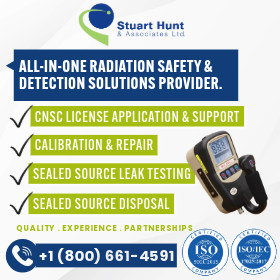2021 Annual Federal Provincial Territorial Radiation Protection Committee Meeting

The Federal Provincial Territorial Radiation Protection Committee (FPTRPC), created in 1993, aims to advance the development and harmonization of practices and standards for radiation protection within federal, provincial, and territorial jurisdictions, and to communicate these to the people of Canada. This supports the shared responsibility of federal and provincial/territorial governments to keep Canadians safe from unnecessary radiation exposure.
The committee includes representatives from Health Canada (Environmental and Radiation Health Sciences Directorate), Canadian Nuclear Safety Commission (CNSC) (Directorate of Environmental and Radiation Protection and Assessment), and representatives from various ministries in the provinces and territories. The Department of National Defence also participates, and Employment and Social Development Canada’s Labour Program acts as an observer.
The committee meets every year to allow radiation protection regulatory officials from across Canada to share information, discuss challenges, and recommend courses of action. The latest meetings took place virtually on October 18, 20, and 22. A training day for committee members took place on October 26.
Provincial and territorial members in attendance presented information regarding committee areas of interest, which had been determined earlier in the year. This format provided a better understanding of regional differences and allowed members to share best practices regarding nationwide issues.
Topics included:
- Radiation protection during medical radiographic imaging
- Awareness of information on Health Canada’s website and use of that information
- Emerging issues related to radiation-emitting devices
- Provincial/territorial jurisdictional oversight of radiation equipment, workers who use this equipment, and radiation service providers and suppliers
- Radiation trade barriers within Canada
- Laser safety
Health Canada made presentations on the following topics:
- Updates to the National Radon Program
- Future revisions to the Guidelines for Canadian Drinking Water Quality
- Canadian Guidelines for the Management of Naturally Occurring Radioactive Materials (NORM)
- Completion of the Emergency Preparedness Review (EPREV) in preparation for the International Atomic Energy Agency (IAEA) 2023 follow-up mission [1]
- Revisions to Safety Code 30 (dental X-ray equipment)
- Measuring psychosocial impact of a nuclear emergency on Canadians
- United Nations Scientific Committee on the Effects of Atomic Radiation (UNSCEAR) activities
CNSC shared information on the following:
- Improvements to CNSC’s radiation protection regulatory framework
- The Perceived Risk Advisory Group
Health Canada and CNSC also gave a joint presentation on the Canadian Organization on Health Effects from Radiation Exposure.
During the annual business meeting, members heard reports from the various working groups, appointed a new vice provincial/territorial chair, and discussed some trends in their jurisdictions.
The executive members for 2021–22:
- Federal co-chair – Caroline Purvis, CNSC
- Acting federal co-chair – Keith Henderson, Health Canada
- Federal co-chair (alternate) – Narine Martel, Health Canada
- Provincial/territorial co-chair – Brent Preston, Saskatchewan Ministry of Labour Relations and Workplace Safety
- Provincial/territorial vice co-chair – Ingvar Fife, CancerCare Manitoba
- Past provincial/territorial co-chair – Colleen Rogerson, Nova Scotia Department of Labour and Advanced Education
The meeting concluded with an interactive training session on the lifecycle of a positron emission tomography–computed tomography (PET-CT) machine, facilitated by Health Canada. The purpose was to exchange knowledge, identify gaps, and propose solutions and improvements to current processes. This included presentations and discussions with use of a Jamboard to capture comments and issues raised.
At the session, Health Canada and CNSC presented on federal roles in the regulation of a medical radiation emitting device. Participating members discussed lifecycles of PET-CT machines in their jurisdictions, shared information on regulations, processes, roles, stakeholders, and challenges from acquisition to disposal (including installation, approval, operation, and use).
For more information
If you would like more information about FPTRPC activities, please visit the Health Canada website.
Footnote
[1] In February 2020, the International Atomic Energy Agency (IAEA) published a report following an 11-day mission to review Canada’s emergency preparedness and response framework for nuclear emergencies. The Emergency Preparedness Review (EPREV) mission to Canada was conducted at the request of the Government of Canada and it was the first for any G-7 country. Canada developed an action plan in response to the IAEA findings, which will further strengthen Canada’s nuclear emergency preparedness and response system in preparation for the IAEA’s follow-up EPREV mission, planned for 2023.
Do you want to read more articles like this?
The Bulletin is published by the Canadian Radiation Protection Association (CRPA). It’s a must-read publication for radiation protection professionals in Canada. The editorial content delivers the insights, information, advice, and valuable solutions that radiation protection professionals need to stay at the forefront of their profession.
Sign up today and we’ll send you an email each time a new edition goes live. In between issues, check back often for updates and new articles.
Don’t miss an issue. Subscribe now!
Subscribe



